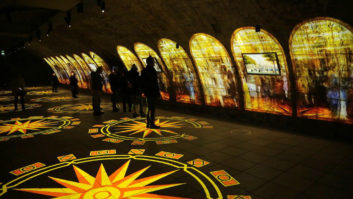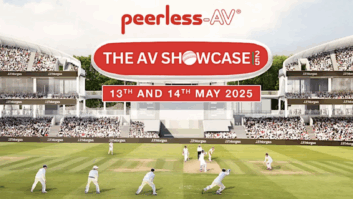Sports venues are the ideal stage for projection mapping. Mike Garrido, senior product manager, Christie, outlines some recent projects and future trends
For today’s sports venue owners, living up to the immense expectations of fans is a challenge in today’s digitally-connected, social and technology-fluent world. Although the sports themselves will always be the reason fans attend, there is a growing demand for stadium owners to enhance the non-game aspects of live sporting events to create truly unique and enriching fan experiences. Large screens displaying spectator relevant information, as well as replaying incidents from games and matches, is now commonplace in most large stadia worldwide. In a related technology development, in this case projection, enterprising arena and stadia are also embracing projection mapping, and specifically, playing surface mapping (PSM).
PSM is a big, bold and exciting way to energise fans in a stadium or auditorium. By presenting amazing visuals projected right on the playing surface – and it could be an ice rink, basketball court, or football pitch – one has a great way to engage and entertain fans.
Importantly for many venues competing with TV audiences, it also gives spectators added motivation to get off the couch and make the trip to the actual venue. Getting fans to the arena was important for the Spanish basketball team, Valencia Basket, when its 30th anniversary occurred recently.
Valencia Basket play at the La Fonteta Pavilion in the city, and the anniversary coincided with the third leg of Valencia’s Endesa League semi-final versus Baskonia. Ten minutes before the match got underway, the lights were turned down in the arena and the court was turned into a gigantic 25 x 15 metre screen onto which a spectacular 3D video mapping show commemorating their thirty-year history was projected. Another basketball team, the Cleveland Cavaliers of the National Basketball Association (NBA), added a new dimension to its games with projection mapping at halftime and during timeouts.
Using a combination of 3D mapping techniques and video content produced by the Cavalier’s internal creative team, the court is transformed into an immersive environment featuring a classic ‘pong’-style game with spectators competing against each other. Participants from the crowd come down to each end of the court to battle it out using motion-tracking rackets that pass the virtual ball back and forth from one end of the court to the other. An additional benefit for the owner is the sponsorship opportunities offered by the interactive game, as Eric Gazzillo, of Quince Imaging, the creative agency behind the game relates: “We created something with the interactive gaming that fans haven’t seen before. Teams are always trying to develop additions to their menu of sponsorship opportunities. Interactive court projection or games are a menu item that are going to be very attractive to sponsors.”
The draw for teams and sponsors is that during a timeout or a long stoppage in play, fans are looking at the court surface. Gazzillo also learned that sponsors are not just interested in the fan experience in the arena, but also after the event when the experience has spread across social media, websites and other online platforms. “We introduced the interactive games because those are attractive to the fans who will then put the experience on Instagram, Facebook Live, and other social media sites. We try to get something unique to get the fans excited, get them tweeting and putting it on Snapchat.”
Creating complex, visual experiences, such as sports-venue projection mapping can be costly, time-consuming and challenging for any venue; the technical logistics required are complex. There are solutions available, such as Christie Mystique. The system is built on the three pillars of design, install and operate, with each facet of the system solving the specific challenges encountered at these stages on a complex multi-screen, multi-projector and blended installation.
Mystique Design features software tools to help integrators and clients design, validate, simulate and visualie any complex projection system. Mystique Install helps integrators through the installation and calibration process, including projector stacking. And Mystique Operate features system-level monitoring to ensure the overall system quality is maintained over its lifetime. A good example of the system in action is at the T-Mobile Arena, the home of National Hockey League (NHL) team, the Vegas Golden Knights – a professional ice hockey team based in Las Vegas. The challenge is not just competing with TV audiences, but with the multitude of attractions offered by the entertainment capital of the world.
Image Engineering, a specialist in effect designs and large spectacles (primarily in professional sport), was brought onboard by the Golden Knights to handle the full game presentation, including audiovisual integration. “We took a lot of care to figure out an installation plan that was going to work for T-Mobile Arena because they do have so many large concerts and one-off shows that come in and out so frequently,” explains Ian Bottiglieri, Director of Project Management, Image Engineering.
The installation features 12 projectors in “pods” of two near each face-off circle, each blue line, and at centre ice, on each side of the arena. Image Engineering then used Christie Mystique to align the projectors, saving both themselves and the Golden Knights what would normally be between eight to 10 hours every time the projectors needed realignment after being repositioned for a concert or other event. “It took about four to five hours to get Mystique setup and running for the first time. After that, we didn’t even really need to think about our alignment because we just needed to block out a 15-minute time period to be able to run the Mystique system and everything would be realigned and perfectly warped and blended,” added Bottiglieri.
While currently, PSM is primarily used as an entertainment tool, owners and teams are discovering innovative ways to employ PSM as an integral training and analytical tool to augment practice and player development. With developments like this in the pipeline, the future looks exciting.






